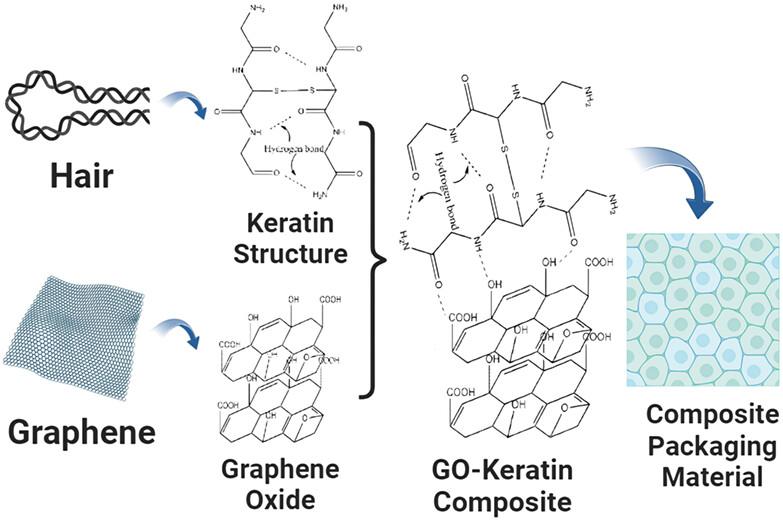Md Ashikur Rahaman Noyon, Md. Elias Uddin, Thuhin Kumar Dey, Mamun Jamal, Gokulkumar Sivanantham, Rashedul Islam
求助PDF
{"title":"由废弃头发角蛋白和氧化石墨烯制成的可生物降解复合材料,具有更好的机械、热和阻隔性能:废弃材料的生态友好型解决方案","authors":"Md Ashikur Rahaman Noyon, Md. Elias Uddin, Thuhin Kumar Dey, Mamun Jamal, Gokulkumar Sivanantham, Rashedul Islam","doi":"10.1002/pi.6586","DOIUrl":null,"url":null,"abstract":"<p>In recent years, there has been a growing concern to counter environmental pollution, and as a result the development of biodegradable materials in various applications has become a major focus. This study aimed to fabricate a biodegradable composite by utilizing discarded hair keratin from beamhouse processing in leather production along with incorporating graphene oxide (GO) to reduce pollution. The composite was prepared using a simple solution mixing method, where the amino functional group of keratin and the carboxyl group of GO were covalently bonded under a redox system. Various analyses, including UV–visible spectroscopy, Fourier transform infrared spectroscopy, Raman spectroscopy, SEM, biodegradability and oxygen gas transmittance rate, were carried out to evaluate the composite's structure and performance. The results demonstrated that GO was successfully integrated into the keratin matrix, with uniform dispersion of GO observed instead of agglomeration. The composite with the optimum ratio exhibited a 173.98% increase in tensile strength and a 33.52% decrease in elongation as well as improved thermal and biodegradation properties compared to pure keratin. Furthermore, the composite displayed significantly better gas barrier properties (39%) than pure keratin, which can be attributed to the reduction of intermolecular gaps through the composite's strong bonding. Hence, the keratin-GO composite is a cost-effective and biodegradable solution to waste materials, with potential use as a packaging material. © 2023 Society of Chemical Industry.</p>","PeriodicalId":20404,"journal":{"name":"Polymer International","volume":"73 3","pages":"230-237"},"PeriodicalIF":2.9000,"publicationDate":"2023-10-28","publicationTypes":"Journal Article","fieldsOfStudy":null,"isOpenAccess":false,"openAccessPdf":"","citationCount":"0","resultStr":"{\"title\":\"Biodegradable composite from discarded hair keratin and graphene oxide with improved mechanical, thermal and barrier properties: an eco-friendly solution to waste materials\",\"authors\":\"Md Ashikur Rahaman Noyon, Md. Elias Uddin, Thuhin Kumar Dey, Mamun Jamal, Gokulkumar Sivanantham, Rashedul Islam\",\"doi\":\"10.1002/pi.6586\",\"DOIUrl\":null,\"url\":null,\"abstract\":\"<p>In recent years, there has been a growing concern to counter environmental pollution, and as a result the development of biodegradable materials in various applications has become a major focus. This study aimed to fabricate a biodegradable composite by utilizing discarded hair keratin from beamhouse processing in leather production along with incorporating graphene oxide (GO) to reduce pollution. The composite was prepared using a simple solution mixing method, where the amino functional group of keratin and the carboxyl group of GO were covalently bonded under a redox system. Various analyses, including UV–visible spectroscopy, Fourier transform infrared spectroscopy, Raman spectroscopy, SEM, biodegradability and oxygen gas transmittance rate, were carried out to evaluate the composite's structure and performance. The results demonstrated that GO was successfully integrated into the keratin matrix, with uniform dispersion of GO observed instead of agglomeration. The composite with the optimum ratio exhibited a 173.98% increase in tensile strength and a 33.52% decrease in elongation as well as improved thermal and biodegradation properties compared to pure keratin. Furthermore, the composite displayed significantly better gas barrier properties (39%) than pure keratin, which can be attributed to the reduction of intermolecular gaps through the composite's strong bonding. Hence, the keratin-GO composite is a cost-effective and biodegradable solution to waste materials, with potential use as a packaging material. © 2023 Society of Chemical Industry.</p>\",\"PeriodicalId\":20404,\"journal\":{\"name\":\"Polymer International\",\"volume\":\"73 3\",\"pages\":\"230-237\"},\"PeriodicalIF\":2.9000,\"publicationDate\":\"2023-10-28\",\"publicationTypes\":\"Journal Article\",\"fieldsOfStudy\":null,\"isOpenAccess\":false,\"openAccessPdf\":\"\",\"citationCount\":\"0\",\"resultStr\":null,\"platform\":\"Semanticscholar\",\"paperid\":null,\"PeriodicalName\":\"Polymer International\",\"FirstCategoryId\":\"92\",\"ListUrlMain\":\"https://onlinelibrary.wiley.com/doi/10.1002/pi.6586\",\"RegionNum\":4,\"RegionCategory\":\"化学\",\"ArticlePicture\":[],\"TitleCN\":null,\"AbstractTextCN\":null,\"PMCID\":null,\"EPubDate\":\"\",\"PubModel\":\"\",\"JCR\":\"Q2\",\"JCRName\":\"POLYMER SCIENCE\",\"Score\":null,\"Total\":0}","platform":"Semanticscholar","paperid":null,"PeriodicalName":"Polymer International","FirstCategoryId":"92","ListUrlMain":"https://onlinelibrary.wiley.com/doi/10.1002/pi.6586","RegionNum":4,"RegionCategory":"化学","ArticlePicture":[],"TitleCN":null,"AbstractTextCN":null,"PMCID":null,"EPubDate":"","PubModel":"","JCR":"Q2","JCRName":"POLYMER SCIENCE","Score":null,"Total":0}
引用次数: 0
引用
批量引用



 求助内容:
求助内容: 应助结果提醒方式:
应助结果提醒方式:


